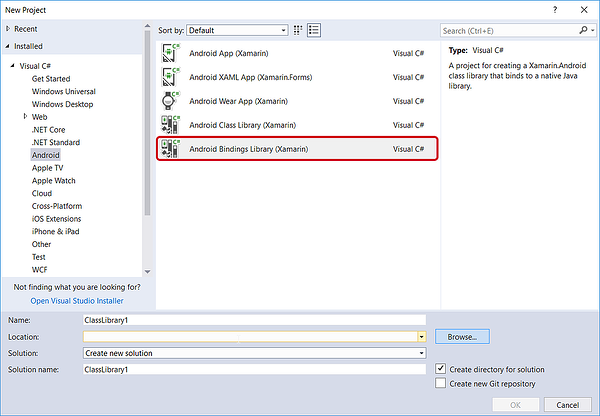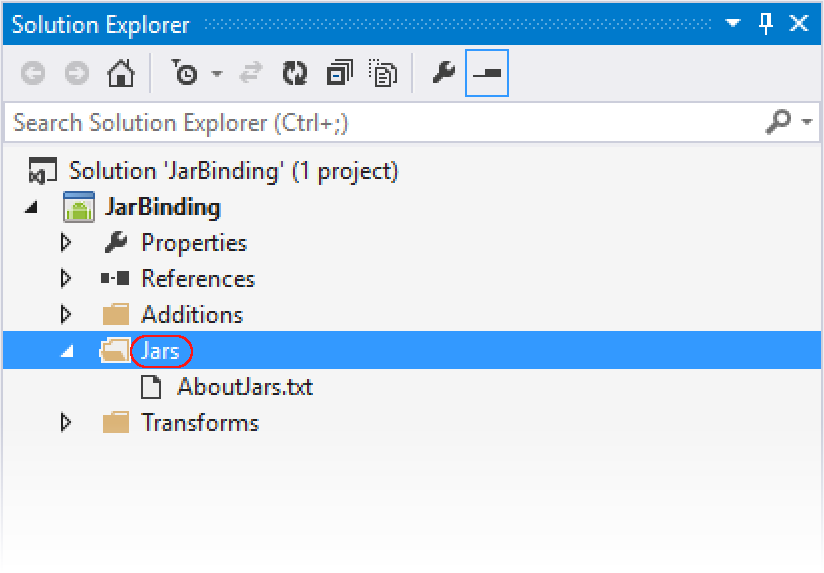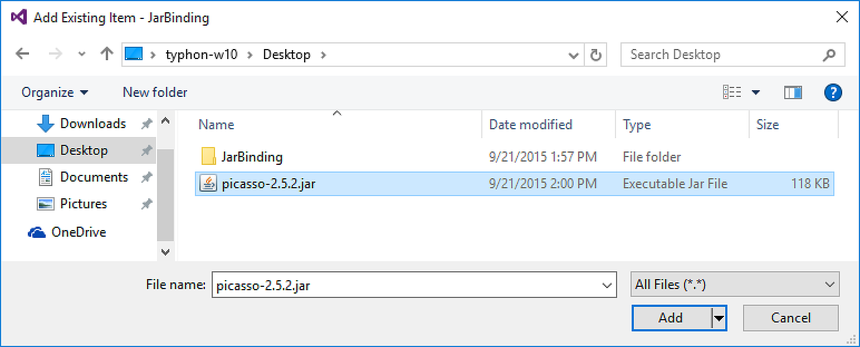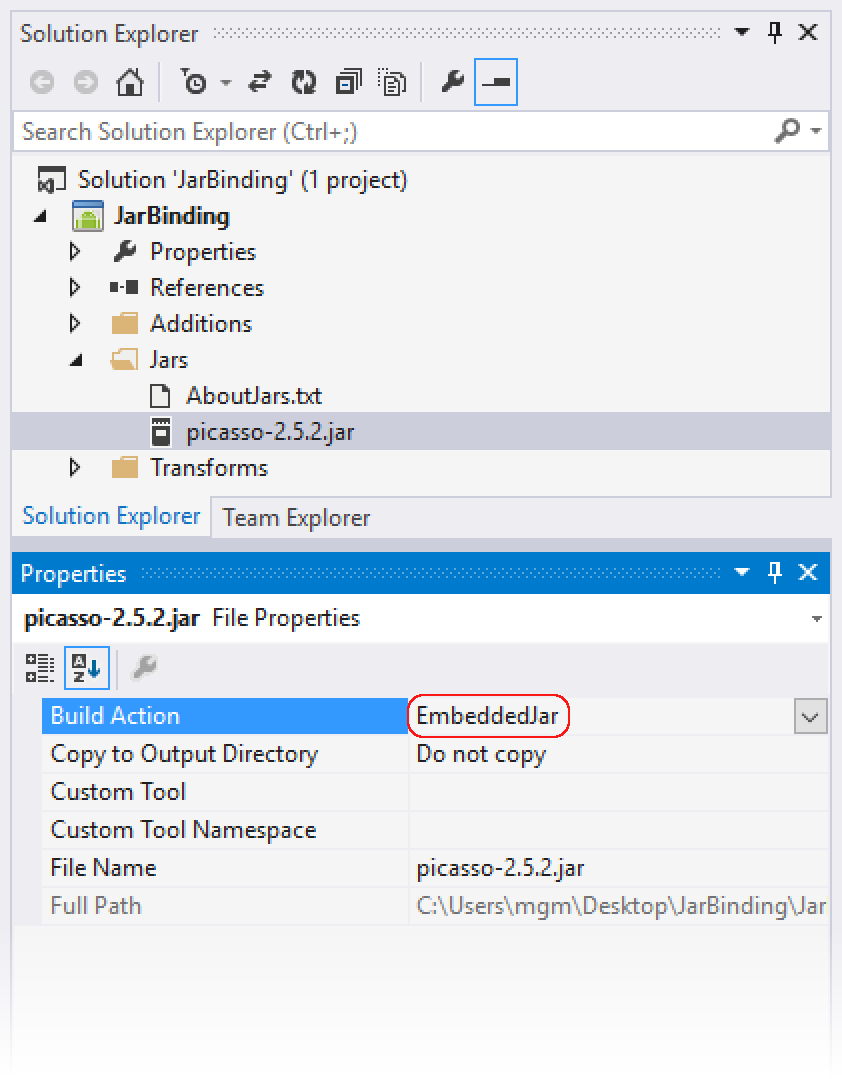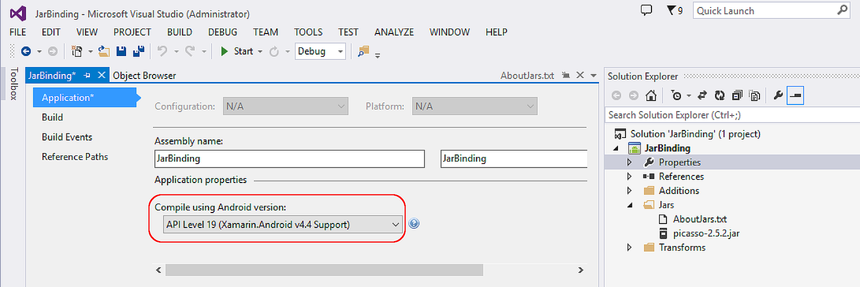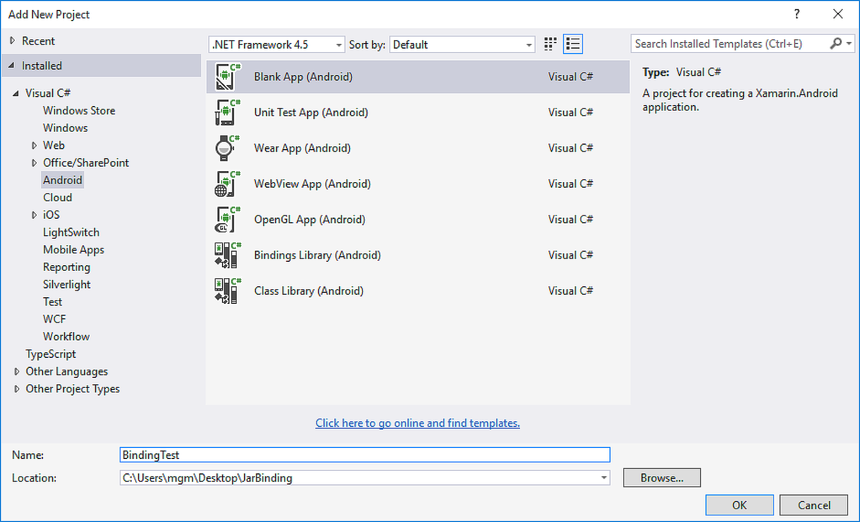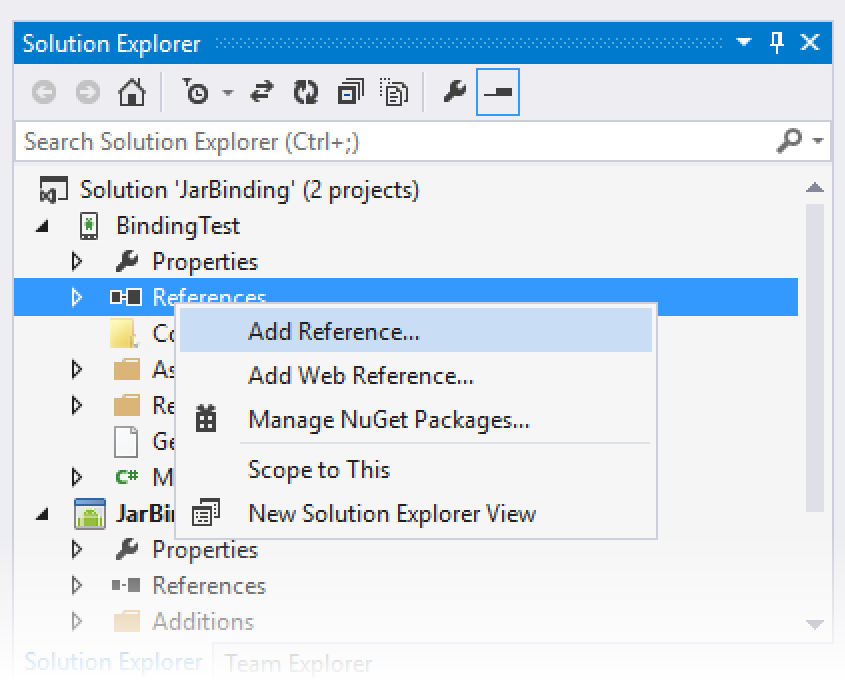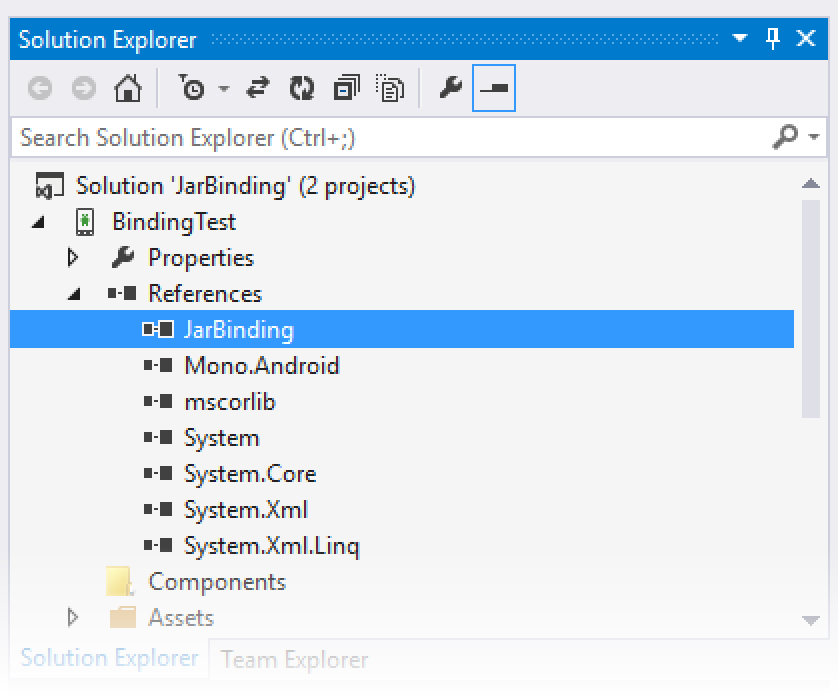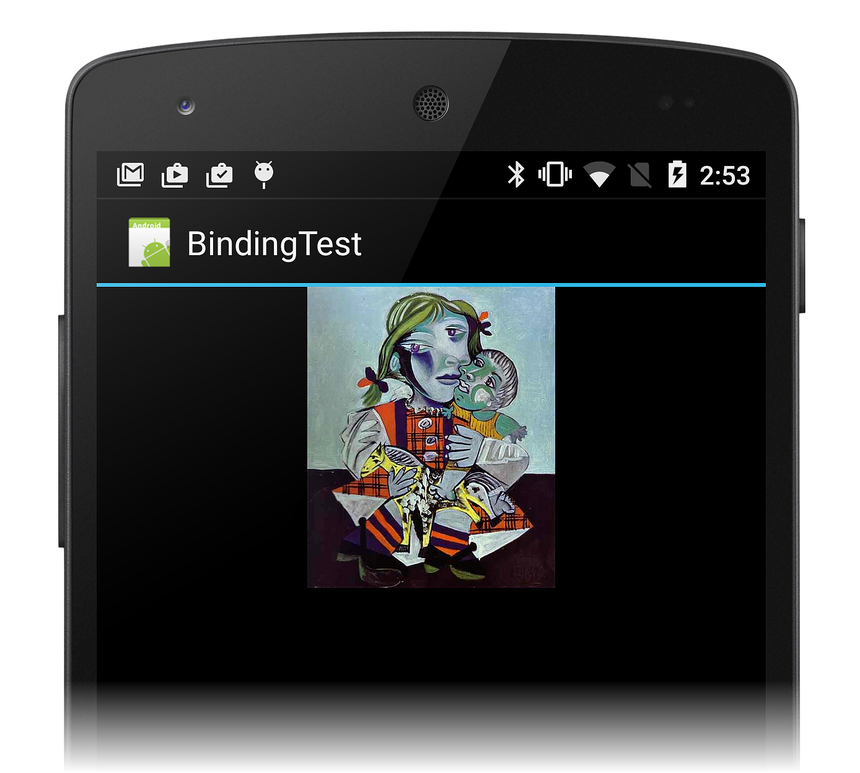Binding a .JAR
Important
We're currently investigating custom binding usage on the Xamarin platform. Please take this survey to inform future development efforts.
This walkthrough provides step-by-step instructions for creating a Xamarin.Android Java Bindings Library from an Android .JAR file.
Overview
The Android community offers many Java libraries that you may want to use in your app. These Java libraries are often packaged in .JAR (Java Archive) format, but you can package a .JAR it in a Java Bindings Library so that its functionality is available to Xamarin.Android apps. The purpose of the Java Bindings library is to make the APIs in the .JAR file available to C# code through automatically-generated code wrappers.
Xamarin tooling can generate a Bindings Library from one or more input .JAR files. The Bindings Library (.DLL assembly) contains the following:
The contents of the original .JAR file(s).
Managed Callable Wrappers (MCW), which are C# types that wrap corresponding Java types within the .JAR file(s).
The generated MCW code uses JNI (Java Native Interface) to forward your API calls to the underlying .JAR file. You can create bindings libraries for any .JAR file that was originally targeted to be used with Android (note that Xamarin tooling does not currently support the binding of non-Android Java libraries). You can also elect to build the Bindings Library without including the contents of the .JAR file so that the DLL has a dependency on the .JAR at runtime.
In this guide, we'll step through the basics of creating a Bindings Library for a single .JAR file. We'll illustrate with an example where everything goes right – that is, where no customization or debugging of bindings is required. Creating Bindings Using Metadata offers an example of a more advanced scenario where the binding process is not entirely automatic and some amount of manual intervention is required. For an overview of Java library binding in general (with a basic code example), see Binding a Java Library.
Walkthrough
In the following walkthrough, we'll create a Bindings Library for Picasso, a popular Android .JAR that provides image loading and caching functionality. We will use the following steps to bind picasso-2.x.x.jar to create a new .NET assembly that we can use in a Xamarin.Android project:
Create a new Java Bindings Library project.
Add the .JAR file to the project.
Set the appropriate build action for the .JAR file.
Choose a target framework that the .JAR supports.
Build the Bindings Library.
Once we've created the Bindings Library, we'll develop a small Android app that demonstrates our ability to call APIs in the Bindings Library. In this example, we want to access methods of picasso-2.x.x.jar:
package com.squareup.picasso
public class Picasso
{
...
public static Picasso with (Context context) { ... };
...
public RequestCreator load (String path) { ... };
...
}
After we generate a Bindings Library for picasso-2.x.x.jar, we can call these methods from C#. For example:
using Com.Squareup.Picasso;
...
Picasso.With (this)
.Load ("https://mydomain.myimage.jpg")
.Into (imageView);
Creating the Bindings Library
Before commencing with the steps below, please download picasso-2.x.x.jar.
First, create a new Bindings Library project. In Visual Studio for Mac or Visual Studio, create a new Solution and select the Android Bindings Library template. (The screenshots in this walkthrough use Visual Studio, but Visual Studio for Mac is very similar.) Name the Solution JarBinding:
The template includes a Jars folder where you add your .JAR(s) to the Bindings Library project. Right-click the Jars folder and select Add > Existing Item:
Navigate to the picasso-2.x.x.jar file downloaded earlier, select it and click Add:
Verify that the picasso-2.x.x.jar file was successfully added to the project:
When you create a Java Bindings library project, you must specify whether the .JAR is to be embedded in the Bindings Library or packaged separately. To do that, you specify one of the following build actions:
EmbeddedJar – the .JAR will be embedded in the Bindings Library.
InputJar – the .JAR will be kept separate from the Bindings Library.
Typically, you use the EmbeddedJar build action so that the .JAR is automatically packaged into the bindings library. This is the simplest option – Java bytecode in the .JAR is converted into Dex bytecode and is embedded (along with the Managed Callable Wrappers) into your APK. If you want to keep the .JAR separate from the bindings library, you can use the InputJar option; however, you must ensure that the .JAR file is available on the device that runs your app.
Set the build action to EmbeddedJar:
Next, open the project Properties to configure the Target Framework. If the .JAR uses any Android APIs, set the Target Framework to the API level that the .JAR expects. Typically, the developer of the .JAR file will indicate which API level (or levels) that the .JAR is compatible with. (For more information about the Target Framework setting and Android API levels in general, see Understanding Android API Levels.)
Set the target API level for your Bindings Library (in this example, we are using API level 19):
Finally, build the Bindings Library. Although some warning messages may be displayed, the Bindings Library project should build successfully and produce an output .DLL at the following location: JarBinding/bin/Debug/JarBinding.dll
Using the Bindings Library
To consume this .DLL in your Xamarin.Android app, do the following:
Add a reference to the Bindings Library.
Make calls into the .JAR through the Managed Callable Wrappers.
In the following steps, we'll create a minimal app that uses the
Bindings Library to download and display an image in an ImageView;
the "heavy lifting" is done by the code that resides in the .JAR file.
First, create a new Xamarin.Android app that consumes the Bindings Library. Right-click the Solution and select Add New Project; name the new project BindingTest. We're creating this app in the same Solution as the Bindings Library in order to simplify this walkthrough; however, the app that consumes the Bindings Library could, instead, reside in a different Solution:
Right-click the References node of the BindingTest project and select Add Reference...:
Check the JarBinding project created earlier and click OK:
Open the References node of the BindingTest project and verify that the JarBinding reference is present:
Modify the BindingTest layout (Main.axml) so that it has a single ImageView:
<?xml version="1.0" encoding="utf-8"?>
<LinearLayout xmlns:android="http://schemas.android.com/apk/res/android"
android:orientation="vertical"
android:layout_width="match_parent"
android:layout_height="match_parent"
android:minWidth="25px"
android:minHeight="25px">
<ImageView
android:layout_width="match_parent"
android:layout_height="wrap_content"
android:id="@+id/imageView" />
</LinearLayout>
Add the following using statement to MainActivity.cs – this makes it possible
to easily access the methods of the Java-based Picasso class that resides in the
Bindings Library:
using Com.Squareup.Picasso;
Modify the OnCreate method so that it uses the Picasso class to
load an image from a URL and display it in the ImageView:
public class MainActivity : Activity
{
protected override void OnCreate(Bundle bundle)
{
base.OnCreate(bundle);
SetContentView(Resource.Layout.Main);
ImageView imageView = FindViewById<ImageView>(Resource.Id.imageView);
// Use the Picasso jar library to load and display this image:
Picasso.With (this)
.Load ("https://i.imgur.com/DvpvklR.jpg")
.Into (imageView);
}
}
Compile and run the BindingTest project. The app will startup, and after a short delay (depending on network conditions), it should download and display an image similar to the following screenshot:
Congratulations! You've successfully bound a Java library .JAR and used it in your Xamarin.Android app.
Summary
In this walkthrough, we created a Bindings Library for a third-party .JAR file, added the Bindings Library to a minimal test app, and then ran the app to verify that our C# code can call Java code residing in the .JAR file.
